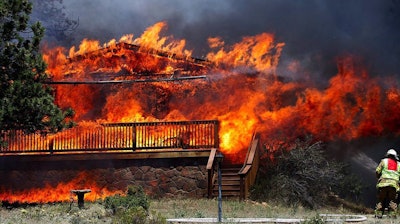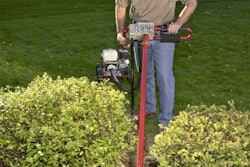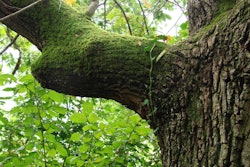 Fire consumed a home in Estes Park, Colorado, on June 23, 2012. This fire claimed as many as 21 structures. Photo: Darrell Spangler/AP
Fire consumed a home in Estes Park, Colorado, on June 23, 2012. This fire claimed as many as 21 structures. Photo: Darrell Spangler/APAfter 19 firefighters lost their lives near Yarnell, Arizona this summer from a wildfire, many people have turned their attention on how to prevent these extreme fires.
Reports show there are about two-dozen wildfires spreading across the western United States continuing to threaten homes, lives and the environment.
Because of this, landscapers across the country can help prevent fires from spreading.
Leonard Perry, an Extension Professor at the University of Vermont Extension, has offered a few informed suggestions on how to prevent a fire-resistant landscape.
According to Perry, it’s not expensive to create a fire-safe landscape, but it’s more important “how” materials are planted as opposed to “what” is planted.
- Keep nearby trees pruned so they don’t overhang roofs, preferably 10 feet away.
- If trees are more than 18 feet tall, prune branches at least 6 feet from the ground. This will help prevent lower branches from igniting should there be a low ground fire and spreading upward — the “fire ladder” effect.
- If in a wooded area, try and keep trees and native vegetation cleared within 50 feet of the home or structures — the “fire safe” or “defensible” space. Beyond that, it may be good to thin the vegetation by 50 percent the next 50 feet.
- Keep trees furthest from the house, shrubs closer, and flowers or lawn nearest the house. Keep plants near buildings from drying out. All plants will burn, but healthy ones burn much slower. Adding plenty of compost and peat moss to beds increases their water-holding capacity, so helps keep plants from drying out.
- Keep dead twigs pruned from shrubs and trees, and of course remove dead plants that will only dry up and create potential fuel for fires.
- Similarly, keep fallen leaves raked from under plants, especially near homes.
- Don’t mow dry grass. This not only helps the grass survive, but avoids the potential for sparks from mowers to ignite dry grass and thatch.
When choosing plants for a fire-resistant landscape, select those with:
- the least seasonal (usually fall) dropping of leaves or needles for conifers
- open branching habits (they provide less fuel for fires)
- non-resinous sap (that is those without thick, sticky sap such as junipers, pines, spruces, and firs)
- less total branches and leaves (again, less fuel for fires)
- high moisture content in leaves (these burn and ignite more slowly); avoid ornamental grasses next to homes
- drought tolerance
- slow growth, so less pruning (to keep open as noted above)
Some examples of hardy, fire-resistant plants to consider for northern landscapes include:
- perennials–yarrow, bergenia, coreopsis, coralbells, daylilies, hosta, iris, perennial geraniums
- groundcovers–ajuga, bearberry, pachysandra, creeping phlox, sedum
- shrubs (deciduous)– burning bush, mockorange, spirea, snowberry, lilac, roses, viburnums
- shrubs (evergreen)–cotoneaster, Carol Mackie daphne
- trees (tall)–many deciduous such as maples, beech, ash, mountain ash, willow
- trees (short)– serviceberry, birch










